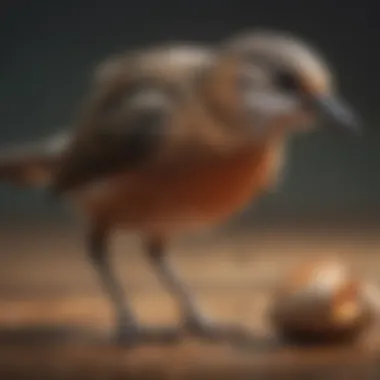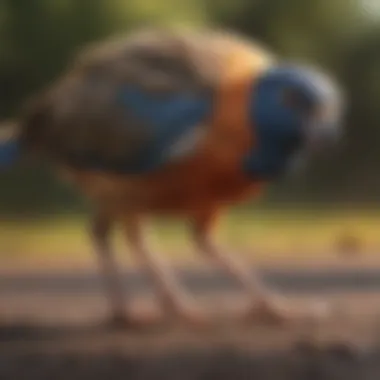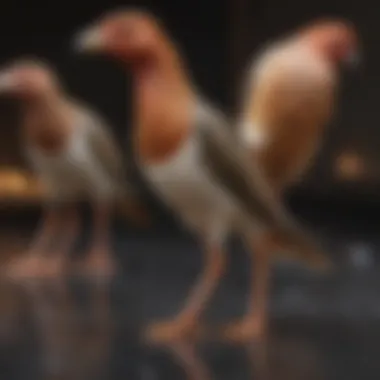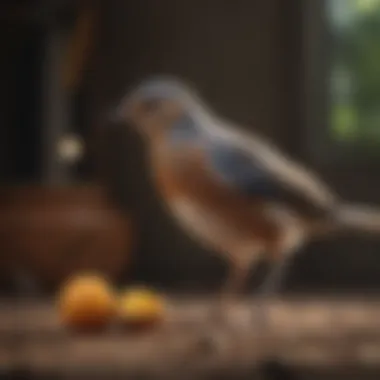Understanding Broken Bird Legs: Causes, Treatment, Prevention


Intro
Understanding your pet's well-being is crucial, especially when it comes to their health. Broken legs in birds, for instance, is a serious issue that can lead to pain and mobility problems. The knowledge of causes, treatment options, and preventative strategies is vital for any pet owner. This section aims to shed light on the important aspects of avian health, focusing specifically on broken bird legs.
Understanding Your Pet
Pet Behavior Basics
Birds communicate their needs and stress levels through behavior. Recognizing unusual behaviors can hint at potential health problems, including leg injuries. Active birds typically engage in hopping and climbing, while injured birds may sit still, reluctant to move, or avoid using one leg. This behavior signals a need for careful observation.
Common Breed Characteristics
Different breeds may exhibit distinct characteristics and behaviors. For example, larger birds like macaws can suffer leg injuries due to their weight and activity levels, whereas smaller species might be more agile but still prone to falls or accidents. Understanding these breed-specific traits helps owners anticipate the risks that may lead to injuries.
Species-Specific Needs
Each bird species has unique requirements concerning environment and care. Parrots, for instance, thrive in interactive settings, while canaries prefer quiet spaces. Providing a tailored environment reduces stress and minimizes the chances of accidents. Keeping cages safe and clutter-free is essential.
Pet Care and Maintenance
Feeding Guidelines
A balanced diet is fundamental for overall health, including bone strength. Birds need a mix of seeds, fruits, and specially formulated pellets. Proper nutrition supports strong bones and reduces the risk of fractures. Avoid feeding harmful foods, such as chocolate or avocado.
Grooming Essentials
Regular grooming is vital for a bird's health. Nail trimming is particularly important, as overgrown nails can lead to balance issues, increasing the risk of falls and resultant injuries. Although grooming may seem minor, it plays a significant role in preventing accidents.
Hygiene Practices
Maintaining hygiene in a bird’s environment is crucial. Dirty cages can lead to health issues that may affect leg health. Regular cleaning minimizes bacteria and parasites, both of which can cripple a bird's physical condition and make it susceptible to injuries.
Health and Wellness
Routine Vet Check-ups
Veterinary visits play a significant role in ensuring that birds stay healthy. Regular check-ups help detect underlying issues that can lead to complications, including broken legs. Birds are experts at hiding pain, making these visits essential.
Vaccination Needs
Vaccinations are a preventive measure that shouldn't be overlooked. Diseases such as Psittacosis can weaken a bird, making it more prone to injuries. Keeping vaccinations up to date helps maintain a bird’s strength and resilience.
Recognizing Signs of Illness
Being vigilant about signs of illness is key. If a bird shows signs of lethargy, changes in appetite, or unusual movements, it may indicate a hidden problem. Recognizing these signs early enables quicker intervention, which can prevent severe injuries.
Enrichment and Activities
Indoor vs.
Outdoor Activities
Providing both indoor and outdoor activities enriches a bird's life while reducing stress levels. Outdoor playtime can improve physical condition but also carries risks, such as falls. Indoor activities, including toys and climbing structures, enhance engagement without as much risk.
Interactive Toys and Games
Toys play a significant role in bird health. Interactive toys encourage movement, helping to maintain strong muscles and healthy bones. They also keep a bird mentally stimulated, which can prevent behavioral issues related to boredom.
Socialization Opportunities
Birds are social creatures; therefore, they need interaction to thrive. Regular socialization, whether with other birds or humans, prevents loneliness and behavioral issues. This, in turn, reduces the likelihood of accidents stemming from stress-induced behaviors.


Prolusion to Bird Leg Injuries
Bird leg injuries can be a serious concern for pet owners and bird enthusiasts alike. Understanding these injuries is crucial for effective prevention, treatment, and rehabilitation. Bird legs are critical for their mobility and survival, so any injury can lead to significant complications. Moreover, a timely response can make a major difference in the outcome of such injuries, making education on this topic vital.
The Significance of Understanding Bird Injuries
Apprehending the intricacies of bird leg injuries allows owners to recognize problems early. Many times, a slight lameness can signal a more severe issue. Not understanding the signs can lead to neglect, resulting in prolonged pain and potential suffering for the bird. Furthermore, being informed empowers owners to seek medical help promptly, increasing the chance of a full recovery.
Knowledge about bird injuries extends to understanding normal behavioral patterns. Birds express discomfort in different ways, and being able to interpret these can aid in providing better care.
General Anatomy of Bird Legs
Bird legs have a unique structure, designed for their specific needs. They consist of several key components:
- Femur: This is the upper bone of the leg, connected to the hip joint. It supports the bird's weight and helps in movement.
- Tibia and Fibula: These bones are crucial for the lower part of the leg. They further help in balance and stability.
- Tarsometatarsus: This is a fused group of bones in the lower leg that adds strength. It also provides attachment for muscles essential for movement.
- Toes: Birds typically have four toes, each designed for gripping or perching. The arrangement of these toes varies among species and is important for their adaptability.
Understanding this anatomy helps in assessing the severity of injuries. Different injuries will affect various parts, so this knowledge is beneficial for both prevention strategies and therapeutic approaches.
Common Causes of Broken Bird Legs
Understanding the common causes of broken bird legs is vital for bird owners and enthusiasts. By identifying the potential risks and contributing factors, caregivers can implement better practices to ensure the health and safety of their avian companions. This section examines several key elements: physical trauma, nutritional deficiencies, and genetic factors. Each of these causes plays a significant role in the prevalence of leg injuries among birds.
Physical Trauma
Physical trauma is one of the most frequent reasons for broken legs in birds. Such injuries can occur due to various environmental hazards. For instance, a bird could accidentally fall from a height, collide with objects, or be victim to aggressive interactions with other pets or birds. The severity of the injury often depends on the type of trauma involved.
In many cases, young birds that are still learning to fly are particularly susceptible to such injuries. They may misjudge distances or fail to clear obstacles, leading to dangerous falls. Additionally, outdoor birds may face threats from predators that could lead to broken bones when trying to escape.
To mitigate the risk of physical trauma:
- Ensure that bird enclosures are secure and free of sharp objects.
- Supervise birds during time outside their cages.
- Provide safe environments for young birds to exercise their flying skills.
Nutritional Deficiencies
Nutritional deficiencies can significantly influence a bird's bone health. Birds require a balanced diet rich in vitamins and minerals, particularly calcium and phosphorus, to maintain strong bones. Without these nutrients, bones can weaken, making them more susceptible to fractures even under normal conditions.
For example, a lack of calcium can lead to a condition called metabolic bone disease. This disease is characterized by fragile bones, leading to an increased likelihood of breaks. Birds on seed-only diets may be at risk since seeds often do not supply adequate nutrition.
To prevent nutritional deficiencies:
- Offer a varied diet that includes fruits, vegetables, and fortified pellets.
- Consult a veterinarian for dietary recommendations tailored to your bird's needs.
Genetic Factors
Some birds are predisposed to skeletal issues due to genetic factors. Certain breeds may inherit conditions that compromise their bone density or proper leg structure. In these populations, the risk of injury increases significantly, particularly when combined with environmental stressors.
However, genetic predispositions can often be managed through proper care. Being aware of your bird's genetic background helps in anticipating potential health issues, allowing for preventative measures to be applied early.
In summary, recognizing these common causes of broken bird legs can guide bird owners toward better protection and care strategies. Immediate recognition of risks and proactive management can significantly reduce the chances of leg injuries in birds, enhancing their well-being and longevity. By focusing on trauma prevention, ensuring proper nutrition, and understanding genetic vulnerabilities, caregivers can create a safer living environment for their feathered friends.
Recognizing Signs of a Broken Leg in Birds
Recognizing signs of a broken leg in birds is a critical aspect of avian care. Timely identification can make the difference between successful recovery and serious complications. Bird owners should be knowledgeable about the specific signs that indicate a potential leg injury. This awareness enables prompt veterinary intervention and enhances the overall well-being of the bird. Knowing what to look for can also help prevent further injury during the assessment process.
Behavioral Indicators
Birds are often remarkably good at hiding pain and discomfort, but certain behavioral changes can provide vital clues that something is wrong. A bird with a broken leg may exhibit the following behaviors:
- Limping or Favoring One Leg: The most obvious sign is a change in the way the bird moves. If it is hesitant to put weight on one leg, this often indicates pain or injury.
- Reduced Activity Levels: Birds in pain tend to become less active. This could manifest as extended periods of being perched or avoiding flight.
- Changes in Behavior: If a normally social bird becomes withdrawn or aggressive, it may be responding to discomfort. Changes in vocalization can also indicate distress.
- Over-Grooming: A bird may excessively preen the injured leg, signaling irritation or pain.
- Abnormal Posture: A bird with a leg injury might sit in an unusual position, keeping the injured leg close to its body.
Paying close attention to these indicators allows for quicker action, significantly benefiting the bird's chance for recovery.
Physical Symptoms


Beyond behavioral changes, physical symptoms can provide clear evidence of a leg injury. Some signs to watch for include:
- Swelling or Inflammation: If the leg appears swollen or has a noticeable change in appearance, it suggests injury. This condition is often accompanied by pain.
- Deformity: An obvious bending or misalignment of the leg when compared to the other leg warrants immediate attention.
- Open Wounds or Bruising: Any visible abrasion or discolored skin around the leg area indicates trauma and should be assessed by a veterinarian.
- Non-Weight Bearing: If the bird consistently keeps one leg lifted and shows reluctance to place it on the ground, there is a high likelihood of a fracture or significant injury.
- Screaming or Vocalization When Moved: Many birds vocalize when in pain. If the bird screeches or squawks in response to handling, it often suggests a leg injury.
Recognizing these physical symptoms will aid in assessing the severity of the situation. In summary, the ability to recognize the signs of a broken leg allows for immediate and appropriate care, which is essential for the overall health and recovery of the bird.
Immediate Response to a Broken Bird Leg
A broken leg in a bird is a serious injury that can have significant implications for its health and well-being. The immediacy of the response to such an injury plays a crucial role in determining the bird's recovery trajectory. Understanding how to assess the situation and take appropriate action can be vital for minimizing pain and facilitating healing. Pet owners should remain calm and collected, as panic can further stress an injured bird. All actions taken during the initial response stage should prioritize the bird's safety and comfort.
Evaluating the Injury
When a bird is suspected to have a broken leg, the first step is to evaluate the injury carefully. This evaluation involves observing the bird's behavior and physical state. Some signs that may indicate a broken leg include:
- Limping or inability to bear weight on one leg.
- Swelling or deformities around the joint or bones.
- Visible wounds or bruises that may be indicative of trauma.
- Abnormal positioning of the leg when the bird is at rest.
In the evaluation process, it is essential to limit the bird's movement to prevent further damage. Capturing the bird gently and placing it in a secure, quiet environment is key. Assessing the extent of the injury without applying excessive handling will help in determining the next steps for care.
Temporary First Aid Measures
Once the injury has been evaluated, immediate first aid can be provided to ensure a better outcome. First aid is not a substitute for professional veterinary care, but it can stabilize the bird and minimize suffering. Here are some temporary first aid measures that can be taken:
- Keep the Bird Calm: Lessening the bird's stress is important. A quiet, dark space can help.
- Avoid Movement: Try to keep the bird still. Use a soft cloth or towel to support the bird and prevent movement of the injured leg.
- Ice Application: If there is swelling, applying a soft ice pack wrapped in cloth for short periods can reduce inflammation.
- Control Bleeding: If applicable, applying gentle pressure with clean cloths can help stem any bleeding from wounds.
- Transport Carefully: When transporting the bird to a veterinarian, ensure it is in a secure box to prevent further injury.
Remember, these measures are temporary. Seeing a veterinarian as soon as possible is critical for proper diagnosis and treatment.
Following initial emergency care, prompt veterinary attention must be sought. The sooner professional help is given, the better the chances for recovery.
Veterinary Treatment Options
Veterinary treatment options for broken bird legs are crucial for ensuring swift recovery and long-term health. Understanding these options can guide pet owners in making informed decisions when faced with such a distressing situation. Seeking veterinary care promptly can significantly improve outcomes for birds with leg injuries, as skilled professionals can provide accurate diagnoses and effective treatment plans.
Diagnosing the Injury
Diagnosing a broken leg in birds involves thorough examinations and possibly imaging techniques. A veterinarian will typically start with a visual assessment. They will observe the bird's behavior and physical symptoms. X-rays are often utilized to confirm the presence of fractures and to determine the severity of the injury.
Careful evaluation helps identify complications, such as potential soft tissue damage or joint issues. Accurate diagnosis is essential. It allows for tailored treatment strategies that address the specific needs of each bird. Delaying diagnosis can worsen the condition, emphasizing the need for prompt veterinary consultation.
Surgical Interventions
When it comes to severe fractures, surgical interventions may be necessary. Surgeries can stabilize broken bones effectively. In many cases, orthopedic implants such as pins, plates, or wires, are used to support the healing process.
A well-trained avian surgeon will consider factors such as the bird's size, age, and overall health before proceeding. Post-operative care is as important as the surgery itself. Regular check-ups, appropriate medication, and a safe recovery environment enhance healing outcomes.
Non-Surgical Treatments
Certain injuries may respond well to non-surgical treatments. For these cases, veterinarians often recommend methods like splinting or casting. These options can be effective, particularly for minor fractures or if the injury is not complicated.
Pain management also plays a vital role in the treatment process. In some instances, physical therapy is suggested to help restore mobility and strength gradually.
Effective non-surgical options offer bird owners an alternative that minimizes risks associated with surgery. However, monitoring the bird’s recovery closely is essential to detect any change in condition.
Seeking a veterinarian knowledgeable in avian medicine is critical. They can provide the necessary care and advise pet owners on the best course of action for treatment.
Through careful diagnosis and appropriate treatment strategies, veterinary options greatly improve the chances of recovery and return to normal activity for birds with leg injuries.
Rehabilitation and Recovery
Rehabilitation and recovery are crucial phases when dealing with broken legs in birds. The process does not just involve healing the physical injury; it also emphasizes restoring the bird's confidence and ability to move freely. Understanding these aspects can greatly enhance the recovery journey of any bird dealing with leg injuries.
Physical Therapy for Birds


Physical therapy is often an essential part of rehabilitation for birds recovering from leg injuries. This therapy aims to regain strength, flexibility, and function. Various exercises can be tailored to meet the specific needs of the injured bird, ensuring that rehabilitation targets the affected areas appropriately.
Some common methods of physical therapy for birds include:
- Range of Motion Exercises: Gentle stretching to ensure joints are not stiffening.
- Strength Building: Light resistance activities to rebuild muscle strength around the injured leg.
- Balance Training: Encouraging the bird to maintain its balance can help in regaining confidence in mobility.
It's vital to consult with a veterinarian who specializes in avian care to establish a suitable regimen. Improper practices can impede the healing process and cause further complications.
Monitoring Recovery Progress
Monitoring the recovery of a bird with a broken leg is very important. This process involves observing both physical signs and behavioral changes. Keeping track of these aspects can help identify any potential setbacks early.
Key areas to focus on during recovery include:
- Physical Appearance: Inspect the leg for swelling, discomfort, or signs of infection.
- Mobility: Assess the bird's ability to move and whether it is favoring the injured leg.
- Behavioral Changes: Any shifts in eating habits, social interaction, or activity levels can indicate concerns in recovery.
Regular check-ups with a veterinarian can provide further guidance on the recovery journey and ensure that the bird is on the right track.
Recovery is not just about healing; it involves regaining strength and confidence.
By understanding the significance of rehabilitation and actively monitoring recovery, bird owners can facilitate a smoother journey back to health.
Preventative Measures to Avoid Leg Injuries
Understanding how to prevent leg injuries in birds is critical for their wellbeing. By focusing on a few key aspects, pet owners can significantly reduce the risk of broken legs. This section discusses proper nutrition, safe living environments, and the importance of regular health check-ups.
Proper Nutrition for Bone Health
Nutrition plays a central role in maintaining strong bones and preventing fractures. A balanced diet ensures that birds receive all necessary vitamins and minerals. Calcium is particularly vital, as it helps develop and maintain bone density.
Foods that are beneficial include:
- Dark leafy greens like kale and collard greens
- Fortified seed mixes that contain added supplements
- Fresh fruits such as berries that provide additional vitamins
It's worth noting that some birds may require specialized diets based on their specific species and age. Always consult a vet for the best dietary advice tailored to your bird's needs.
Safe Living Environments
Creating a safe space for birds can greatly minimize the chances of injuries. Birds often explore their surroundings, which can lead to accidents. Therefore, ensuring a well-designed living environment is essential.
Important considerations for safety include:
- Providing secure cages that are spacious enough for movement but also safe from escape.
- Removing sharp objects, small items that can be ingested, or potentially dangerous wires from the area.
- Using non-toxic plants for any indoor greenery to prevent poison.
Enriching an environment with appropriate toys can help birds exercise without the risk of injury. Ensuring proper ventilation and natural light can also contribute to a healthier atmosphere for the pets.
Regular Health Check-Ups
Routine veterinary check-ups are a preventative measure that can catch potential health issues before they escalate. Just like humans, birds benefit from regular assessments to ensure they are healthy and free from disorders.
During these check-ups, the vet can examine bones and limbs to notice any abnormalities. They can give insight into dietary needs or possible environmental adjustments needed to improve your bird's quality of life.
Regular health evaluations play a significant role in the early identification and treatment of health concerns that can affect leg health.
In summary, effective prevention of leg injuries in birds hinges on a multidisciplinary approach, including proper nutrition, creating safe environments, and maintaining diligent health practices.
Closure
Understanding the implications of broken bird legs is essential for any bird owner or enthusiast. The knowledge encapsulated in this article not only underscores the significance of proper intervention but also highlights the variety of factors at play in maintaining the well-being of avian companions. By being aware of the common causes of these injuries, such as physical trauma, nutritional deficiencies, and genetic factors, pet owners can better anticipate potential issues before they escalate.
Recap of Key Points
- Common Causes: Broken bird legs can arise from physical trauma, nutritional deficiencies, and genetic predisposition.
- Signs of Injury: Recognizing both behavioral changes and physical symptoms is crucial for swift action.
- Immediate Response: Quick assessment of the injury and basic first aid can significantly influence recovery outcomes.
- Veterinary Treatment Options: Various approaches exist including surgical interventions, non-surgical treatments, and the importance of accurate diagnosis.
- Rehabilitation: Engaging in physical therapy and regular monitoring enhances recovery progression.
- Preventative Measures: Optimal nutrition, a safe living environment, and health check-ups are key.
Each of these points serves as a building block towards fostering healthier lives for birds, ensuring that when injuries do occur, there is a roadmap for recovery.
The Importance of Vigilance and Care
Vigilance in observing your bird's behavior and physical condition is of utmost importance. Birds often hide their pain, making it essential for caretakers to be observant and proactive. Regular health check-ups and a solid understanding of proper nutrition can prevent many leg injuries from arising in the first place. Ensuring a safe living environment reduces risk factors significantly. The combination of these elements forms a well-rounded approach to avian care, leading to a more rewarding and enriching experience for both the bird and its owner.







